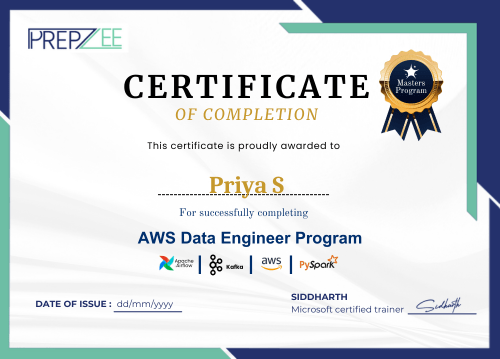













Prepzee's Cloud Masters program changed my career from SysAdmin to Cloud Expert in just 6 months. Thanks to dedicated mentors, I now excel in AWS, Terraform, Ansible, and Python.



Great learning experience through the platform. The curriculum is updated and covers all the topics. The trainers are experts in their respective fields and follow more of a practical approach.



Nice experience, I will recommend it to all the learners who are willing to join and learn IT skills. I was able to switch my domain from non-IT to IT in a reputed MNC


You’re an IT Professional who is looking for a career in Data Engineering especially dealing with Cloud-based solutions.
You’re looking to switch domains into the Future Proof Data Industry without going into Statistics and coding may start in Data Engineering.
You’re a DBA, with experience in database management and SQL, and can transition into data engineering roles with ease.
You’re a Data Analyst/ Scientist who wants to work with data at a larger scale and manage data pipelines that may transition into data engineering.

Including Top 2 Data Engineering Tools according to Linkedin Jobs

Learn by doing multiple labs in your learning journey.

Get a feel of AWS Data Engineering professionals by doing real-time projects.

Call us, E-Mail us whenever you stuck.

Instructors are Microsoft Certified Trainers.

Attend multiple batches until you achieve your Dream Goal.
Python Fundamentals
Setting up Python Virtual Environment
Implementing Conditional Statements
Working with Loops
Exploring Numeric Data Types(Numbers)
Understanding Tuples and Their Operations
Understanding Functions in Python
Working with OOP Concepts
Standard Libraries in Python
Exception Handling in Python
Understanding Structured, Unstructured, and Semi-Structured
Properties of Data: Volume, Velocity, and Variety
Comparing Data Warehouses and Data Lakes
Managing and Orchestrating ETL Pipelines for Data Processing
Data Modeling, Data Lineage, and Schema Evolution
Optimizing Database Performance
Introduction to DataBricks
SparkSession
Understand RDD
Dataframes and its creation
Data sources (using CSV and Parquet) and
dataframe reader
Data targets and Dataframe writer
Spark SQL in PySpark
Spark UI
Databricks Architecture Overview
Databricks cluster pool
Understand Delta lake architecture
Work on Delta lake tables on Databricks
Ingestion, Transformation in Databricks
Work with DataFrames in Databricks
Introduction to AWS Glue
Components of Glue
Glue Data Catalog, Crawlers, Glue Jobs
Use Cases (ETL, data cataloging, job orchestration)
Connecting Glue to other Data sources
Introduction to AWS EMR
EMR Core Concepts
Cluster, Nodes, Master/Core/Task nodes
Use Cases ( Big Data Processing, Spark )
Launching EMR Cluster, EMR Cluster Architecture
Introduction to Redshift
Redshift Objects, Querying & Connections
Setting up Redshift for Data Engineering Projects
Creating Database, Schemas & Users
Loading Data into Redshift
Introduction to Apache Kafka
Understand core concepts of Kafka
Topic, Broker, Producer, Consumer, Partition
What is MSK ( Fully Managed Kafka Service )
Handle Real Time Streaming data using MSK
AWS MSK vs AWS Kinesis vs Self Managed Kafka
Introduction to Amazon Kinesis
Kinesis vs Kafka
Kinesis Data Streams
Kinesis Data Firehose
Introduction to Apache Airflow
Understand Core concepts of Airflow
DAGs, Tasks, Operators, Schedulers
Setting up MWAA (Managed Workflows for Apache Airflow)
Writing/ Scheduling DAG’s
Introduction to AWS Lambda
Creating and Deploying Lambda Functions
Event Sources and Triggers
Monitoring and Debugging Lambda Functions
Introduction to Amazon Athena
Querying Data
Introduction to Dynamo DB
DynamoDB vs RDS vs S3
Reading and Writing Data
Introduction to SageMaker
Bedrock vs SageMaker vs OpenAI API
Building and Training Machine Learning Models
Deploying ML Models
Integrating SageMaker with Other AWS Services
What is Amazon Bedrock?
Key features and benefits
Use cases: Text generation, summarization, image generation, chatbots
Granting IAM permissions
Navigating the Bedrock Console UI
Introduction to Snowflake
Snowflake’s use cases in data engineering
Data Types and Structures in Snowflake
Snowflake Architecture Deep Dive
Cloud Services Layer, Compute Layer, Storage Layer
Data Storage and Performance
Loading Data into Snowflake (Data Engineering)
Data Transformation in Snowflake
Implementing real-time ETL pipelines using Snowflake
Snowflake’s Integration with Data Lake and Data Science Tools
Understanding virtual warehouses in Snowflake
Connecting Snowflake to BI tools like Tableau, Looker, Power BI
Get Mock Interview Sessions
Get guidance to show Projects & Experience in your resume
Get Sample Exam Papers for Certifications
Build ATS Friendly Resume for better Reach
Responsible for designing, implementing, and maintaining data pipelines and infrastructure on AWS, ensuring efficient data processing and analysis.
A Cloud Data Engineer specializes in managing data on cloud platforms, designing scalable solutions using cloud-native tools and services.
Integrates data from multiple sources into a unified ecosystem, designing and implementing data integration workflows.
Designs data architectures on AWS, defining data models and storage structures to meet business requirements
The AWS Platform Data Engineer creates and manages data solutions on AWS, ensuring optimal performance and security. They develop scalable pipelines.
They designs and implements tailored data solutions using advanced tools, focusing on data modeling, pipeline development, and governance for optimal performance and reliability.








online classroom pass
Embark on your journey towards a thriving career in AWS data engineering with best Data Engineering courses. This comprehensive program is meticulously crafted to empower you with the skills and expertise needed to excel in the dynamic world of data engineering. Learn Data Engineering with Prepzee, throughout the program, you’ll explore a wide array of essential tools and technologies, including industry favorites like PySpark, Kafka and Airflow. Dive into industry projects, elevate your CV and LinkedIn presence, and attain mastery in Data Engineer technologies under the mentorship of seasoned experts.
Python Fundamentals
Setting up Python Virtual Environment
Implementing Conditional Statements
Working with Loops
Exploring Numeric Data Types(Numbers)
Understanding Tuples and Their Operations
Understanding Functions in Python
Working with OOP Concepts
Work with Packages
Json Data Handling
CSV file handling
Exception Handling in Python
Understanding Structured, Unstructured, and Semi-Structured
Properties of Data: Volume, Velocity, and Variety
Comparing Data Warehouses and Data Lakes
Managing and Orchestrating ETL Pipelines for Data Processing
Data Modeling, Data Lineage, and Schema Evolution
Optimizing Database Performance
Cloud Computing Introduction
Understand IAAS, PAAS, SAAS
AWS Account Setup & Configuration
Understanding AWS Regions & Availability Zones
Introduction to Amazon Elastic Compute Cloud (EC2)
Benefits of EC2
EC2 Instance Types
Public IP vs. Elastic IP
Introduction to Amazon Machine Image (AMI)
Hardware Tenancy – Shared vs. Dedicated
Introduction to EBS
EBS Volume Types and Snapshots
Introduction to Amazon VPC
Components of VPC: Route Tables, NAT, Network Interfaces, Internet Gateway
Benefits of VPC
IP Addresses
Network Address Translation: NAT Gateway, NAT Devices, and NAT Instance
VPC Peering with Scenarios
VPC: Types, Pricing, Endpoints, Design Patterns
Introduction to Identity Access Management (IAM)
IAM: Policies, Roles, Permissions, Pricing, and Identity Federation
IAM: Groups, Users, Features
Introduction to Resource Access Manager (RAM)
Introduction to Amazon S3
Creating & Managing Buckets
Uploading, downloading, and deleting files
Folder structure for raw, processed, curated zones
Best practices for naming and organizing data lakes
Handling large files with multipart upload
S3 Integration with Data Engineering Services
Storage Class & Lifecycle policies
Architectural Patterns using S3
Introduction to DataBricks
SparkSession
Understand RDD
Dataframes and its creation
Data sources (using CSV and Parquet) and
dataframe reader
Data targets and Dataframe writer
Spark SQL in PySpark
Spark UI
Databricks Architecture Overview
Databricks cluster pool
Understand Delta lake architecture
Work on Delta lake tables on Databricks
Ingestion, Transformation in Databricks
Work with DataFrames in Databricks
Introduction to AWS Glue
Components of Glue
Glue Data Catalog, Crawlers, Glue Jobs
Understanding tables, databases, partitions
Creating and managing a Glue Data Catalog
What are Crawlers?
How to configure and run a crawler
Transformations using AWS Glue
Triggers & Workflows
Use Cases (ETL, data cataloging, job orchestration)
Connecting Glue to other Data sources
Introduction to AWS EMR
EMR Core Concepts
Cluster, Nodes, Master/Core/Task nodes
Master vs. Core vs. Task Nodes
Auto-scaling and spot instance integration
Launch EMR from AWS Console or CLI
Running a Hadoop MapReduce job
Integrating EMR with S3 as a data lake
Use Cases ( Big Data Processing, Spark )
Launching EMR Cluster
EMR Cluster Architecture
Introduction to Redshift
Redshift Objects, Querying & Connections
Setting up Redshift for Data Engineering Projects
Creating Database
Creating Schemas & Users
Creating tables, data types, and primary/foreign keys
Loading Data into Redshift from Glue
Connecting Redshift to Quicksight
Introduction to Apache Kafka
Understand core concepts of Kafka
Topic, Broker, Producer, Consumer, Partition
What is MSK ( Fully Managed Kafka Service )
Handle Real Time Streaming data using MSK
AWS MSK vs AWS Kinesis vs Self Managed Kafka
Introduction to Amazon Kinesis
Kinesis vs Kafka
Kinesis Data Streams
Kinesis Data Firehose
Introduction to Apache Airflow
Understand Core concepts of Airflow
DAGs, Tasks, Operators, Schedulers
Setting up MWAA (Managed Workflows for Apache Airflow)
Writing/ Scheduling DAG’s
Scheduling End to End Pipeline using Airflow
Introduction to AWS Lambda
Creating and Deploying Lambda Functions
Event Sources and Triggers
Monitoring and Debugging Lambda Functions
Introduction to Amazon Athena
Querying Data
Introduction to Dynamo DB
DynamoDB vs RDS vs S3
Reading and Writing Data
Introduction to SageMaker
Bedrock vs SageMaker vs OpenAI API
Create Instance on Sagemaker
Push the Models to EMR using Sagemaker
Deploying ML Models
Integrating SageMaker with Other AWS Services
What is Amazon Bedrock?
Key features and benefits
Use cases: Text generation, summarization, image generation, chatbots
Granting IAM permissions
Navigating the Bedrock Console UI
What is Snowflake?
Snowflake’s use cases in data engineering
Setting up Snowflake
Creating a Snowflake account
Setting up the Snowflake environment
User roles and permissions
Navigating the Snowflake Web UI
Supported data types (BOOLEAN, INTEGER, STRING, etc.)
VARIANT data type for semi-structured data (JSON, XML, Parquet)
Tables (Permanent, Temporary, Transient)
Snowflake Architecture Deep Dive
Cloud Services Layer, Compute Layer, Storage Layer
Micro-partitioning and its benefits
How data is stored and accessed in Snowflake
Time Travel and Fail-safe
Zero Copy Cloning
Snowflake’s automatic scaling and partitioning
Loading Data into Snowflake (Data Engineering)
File formats supported by Snowflake (CSV, JSON, Parquet, Avro)
Using Snowflake’s COPY command
Using Snowflake’s SQL capabilities for ETL
Creating and managing stages
Data Transformation using Streams and Tasks
What are Streams and Tasks?
Implementing real-time ETL pipelines using Snowflake
Automation and scheduling tasks in Snowflake
Snowflake’s Integration with Data Lake and Data Science Tools
Connecting Snowflake to BI tools like Tableau, Looker, Power BI
Understanding virtual warehouses in Snowflake
Optimizing virtual warehouse size and performance
Auto-suspend and auto-resume configurations
Clustering Keys
Query profiling and performance tuning
Caching in Snowflake
Star schema vs Snowflake schema
Authentication and Authorization
Role-based access control (RBAC)
Data encryption at rest and in transit
Auditing and monitoring usage
Setting up data sharing and data masking
Access controls for sensitive data
Sharing data securely with other Snowflake accounts
Using Snowflake’s secure data sharing feature
Data sharing best practices
Get Mock Interview Preparation Sessions
Get guidance to show Projects & Experience in your resume
Get Sample Exam Papers for Certifications
Build ATS Friendly Resume for better Reach
Introduction to cloud computing and DevOps
Infrastructure Setup
Version Control with Git
Containerisation using Docker
Configuration Management Using Ansible
Git, Jenkins & Maven Integration
Continuous Integration with Jenkins
Continuous Orchestration Using Kubernetes
Monitoring using Prometheus and Grafana
Terraform modules and workspaces
Terraform Script Structure
SQL Basics and Data Retrieval
Aggregation and Grouping
Joins and Data Relationships
Data Manipulation and Transactions
Advanced SQL Functions and Conditional Logic
Window Functions and Ranking
Data Definition and Schema Management
Views, Stored Procedures, and Functions
Performance Optimization and Real-World Scenarios
Our tutors are real business practitioners who hand-picked and created assignments and projects for you that you will encounter in real work.
A real-time data pipeline using AWS Kinesis and Snowflake to stream, process, and load data for instant analytics and business intelligence
Designed a Snowflake data pipeline using AWS Kinesis for real-time ingestion and Apache Airflow for orchestration, enabling automated, scalable, and efficient data processing.
Designed an end-to-end ETL pipeline on AWS EMR using Spark for processing, S3 for storage, and Hive for data warehousing and querying.
Developed a comprehensive financial data pipeline using AWS and PySpark to ingest, transform, and analyze large-scale financial data for real-time insights and reporting.
Built an ETL data pipeline for YouTube Analytics to extract video metrics via API, transform using Python, and load into a data warehouse for reporting.

Enrolling in the AWS Data Engineer Job Oriented Program by Prepzee for the AWS Data Engineer certification (DEA C01) was transformative. The curriculum covered critical tools like PySpark, Python, Airflow, Kafka, and Snowflake, offering a complete understanding of cloud data engineering. The hands-on labs solidified my skills, making complex concepts easy to grasp. With a perfect balance between theory and practice, I now feel confident in applying these technologies in real-world projects. Prepzee's focus on industry-relevant education was invaluable, and I’m grateful for the expertise gained from industry professionals.

I enrolled in the DevOps Program at Prepzee with a focus on tools like Kubernetes, Terraform, Git, and Jenkins. This comprehensive course provided valuable resources and hands-on labs, enabling me to efficiently manage my DevOps projects. The insights gained were instrumental in leading my team and streamlining workflows. The program's balance between theory and practice enhanced my understanding of these critical tools. Additionally, the support team’s responsiveness made the learning experience smooth and enjoyable. I highly recommend the DevOps Program for anyone aiming to master these essential technologies.

Enrolling in the Data Engineer Job Oriented Program at Prepzee,, exceeded my expectations. The course materials were insightful and provided a clear roadmap for mastering these tools. The instructors' expertise and interactive learning elements made complex concepts easy to grasp. This program has been invaluable for my professional growth, giving me the confidence to apply these technologies effectively in real-world projects.

Enrolling in the Data Analyst Job Oriented Program at Prepzee, covering Python, SQL, Advanced Excel, and Power BI, was exactly what I needed for my career. The course content was well-structured and comprehensive, catering to both beginners and experienced learners. The hands-on labs helped reinforce key concepts, while the Prepzee team’s support was outstanding, always responsive and ready to help resolve any issues.

Prepzee has been a great partner for us and is committed towards upskilling our employee.Their catalog of training content covers a wide range of digital domains and functions, which we appreciate.The best part was there LMS on which videos were posted online for you to review if you missed anything during the class.I would recommend Prepzee to all to boost his/her learning.The trainer was also very knowledgeable and ready to answer individual questions.


Get Certified after completing AWS Data Engineer full course with Prepzee




